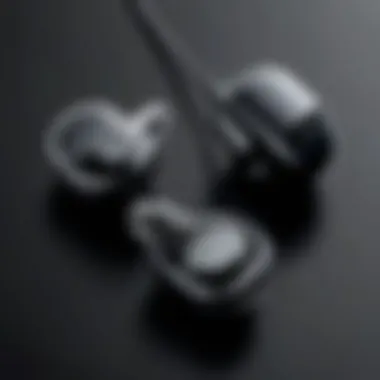iPhone Compatible Earbuds: A Comprehensive Guide


Intro
The demand for high-quality audio experiences has seen a remarkable surge in recent years, particularly among iPhone users. Earbuds have become an integral part of daily life, providing users the convenience of wireless connectivity and delivering exceptional sound quality. This article examines the broad spectrum of earbuds compatible with iPhones, focusing on key specifications, performance metrics, and user experiences. As this industry evolves, understanding the differences among various models, both branded and third-party, is crucial for making an informed purchase.
Product Overview
Description of the Product
Earbuds compatible with iPhones come in various styles and prices. They can range from Apple's own AirPods to budget-friendly alternatives from brands like Anker and Jabra. Each product offers a unique set of features designed to enhance the user experience. It is essential to recognize that while the iPhone provides a universal wireless framework, not all earbuds perform equally well within this ecosystem.
Key Features and Specifications
When considering earbuds, users should pay attention to the following key features:
- Bluetooth Technology: Most modern earbuds utilize Bluetooth 5.0 for improved connectivity and lower latency.
- Battery Life: Different models offer varying battery lives. Some, like Apple's AirPods Pro, can last up to 4.5 hours on a single charge, while others may exceed that.
- Sound Quality: This is a critical factor. Users need to examine the drivers and frequency response to assess audio clarity and bass performance.
- Comfort and Fit: Many models include various ear tip sizes to ensure a proper fit, which is essential for sound isolation.
- Water Resistance: Some earbuds are equipped with IPX ratings, making them more suitable for sports and outdoor activities.
“Choosing the right earbuds is not just about brand; it’s about understanding your personal audio preferences.”
In-Depth Review
Performance Analysis
The performance of earbuds can vary significantly based on models. Apple AirPods provide seamless integration with iOS devices, boasting features such as automatic ear detection and spatial audio. While third-party models like Bose SoundSport Free are celebrated for their robust sound quality and impressive battery life.
- Sound Clarity: Many users report that high-end models excel in producing a balanced audio landscape.
- Latency: Low latency is a key attribute, particularly for video consumption. This feature is found more in recent models with advanced Bluetooth technology.
Usability Evaluation
Usability goes beyond sound quality. The ease of use is fundamental. Features like touch controls or voice assistant integration add to the practicality of using earbuds day-to-day. User feedback often highlights that ease of pairing and reliable connectivity significantly enhance the experience.
Foreword to iPhone Compatible Earbuds
In today's rapidly evolving tech landscape, smartphones have transcended their basic functionalities. They now serve as comprehensive multimedia devices. Among the various accessories that enhance a smartphone's capabilities, earbuds play a significant role, especially for iPhone users. This section aims to emphasize the essence of iPhone compatible earbuds while exploring their various elements and considerations.
The compatibility of earbuds with iPhones is critical. Users seek seamless integration, ensuring that their audio experience matches the device's performance. Earbuds enable users to enjoy music, podcasts, and calls without interruption. Furthermore, they have become an extension of personal style, with different designs catering to diverse preferences.
Notably, the market for iPhone compatible earbuds has diversified. From high-end offerings to budget-friendly options, the choices are vast. This landscape leads to an important consideration: understanding which features matter the most. Sound quality, comfort, and connectivity are essentials not to overlook. Each aspect bears implications not only on user satisfaction but also on the overall functionality of the earbuds.
As we delve into the nuances of earbuds, it becomes clear that this exploration is more than a mere overview. It is a guide for discerning consumers navigating the audio accessory market.
Understanding Compatibility
Compatibility is a paramount concern for users of iPhone compatible earbuds. Not all earbuds function seamlessly with all versions of iPhones, which can lead to a frustrating experience. Many users may not be aware of the specific requirements that ensure optimum performance.
One of the first aspects to consider is the Bluetooth version. iPhones utilize Bluetooth technology for wireless connectivity. Most modern earbuds employ Bluetooth 5.0, which offers a stable connection and extended range. Users should confirm their iPhone model's Bluetooth capabilities to avoid any compatibility issues. If the iPhone is older, like the iPhone 7, it may have limited capabilities with newer earbuds.
Additionally, Apple has their proprietary audio technologies, such as the W1 and chips, which enhance connection speed and reliability with their own products. Earbuds without these chips might not take full advantage of the iPhone's potential.
In summary, compatibility is a critical foundation when selecting earbuds, ensuring the user enjoys a remarkable audio experience paired effortlessly with their iPhone.
The Rise of Wireless Technology
The shift towards wireless technology has revolutionized the way users interact with their devices. Earbuds, once tethered by cables, are now becoming increasingly popular due to advancements in wireless design and technology. This transition aligns with users' desire for convenience and flexibility.
Wireless earbuds offer users liberation from clutter. The absence of cords and wires allows for more freedom, particularly during movement or activities like exercising. Additionally, many wireless earbuds come with charging cases, further enhancing their portability. This trend has also been driven by the growing trend of minimalism in technology design.
As wireless earbuds gain traction, manufacturers are delivering improved functionalities, such as touch controls and voice assistant integration. These features enhance user experience, fostering a deeper connection to the iPhone's ecosystem.
The recent developments in battery technology have also brought enhancements to wireless earbuds. Longer battery life ensures users can enjoy extensive listening without interruptions. The combination of these advancements has solidified the preference for wireless solutions among tech-savvy consumers.
Technical Specifications
Understanding the technical specifications of iPhone compatible earbuds is crucial for informed purchasing decisions. These specifications dictate not only the overall performance but also compatibility, connectivity, and sound quality. Each element plays a significant role in how the earbuds will function with an iPhone.


When evaluating earbuds, consider the following elements:
- Bluetooth versions
- Audio codecs
- Battery life
- Charging methods
Examining these technical specifications reveals the intricacies behind sound performance and user experience, thereby helping buyers make the right choice for their audio needs.
Bluetooth Versions and Their Significance
Bluetooth connectivity is foundational for wireless earbuds. Understanding the different Bluetooth versions helps gauge the performance of earbuds. Each iteration of Bluetooth has introduced improvements. For instance:
- Bluetooth 4.0: Launched improvements in energy efficiency and connection stability.
- Bluetooth 5.0: Offers twice the speed and range compared to 4.2. This means better sound quality and fewer disruptions in audio playback.
The most recent versions tend to offer better battery life and an enhanced experience. Thus, when selecting earbuds, ensure you check the Bluetooth version they utilize. This could affect both sound quality and connectivity reliability.
Audio Codecs: What You Should Know
Audio codecs compress and decompress audio streams, influencing the quality of sound delivered through earbuds. The most relevant codecs include:
- AAC (Advanced Audio Codec): This is the standard for Apple devices. It provides high-quality audio, but its performance can vary based on Bluetooth connection stability.
- APT-X: Known for lower latency, this codec is not natively supported by iPhones, but many Android users appreciate its benefits.
Understanding the codec used by potential earbuds is essential. It determines how efficiently audio is transmitted and can substantially affect listening experience. Users who are serious about sound quality should consider this when choosing compatible earbuds.
Key Brands and Their Offerings
In the realm of iPhone compatible earbuds, key brands play a significant role. These brands are often synonymous with quality, innovation, and user satisfaction. Recognizing the strengths and offerings of each brand allows consumers to make educated choices tailored to their listening preferences and needs.
When it comes to earbuds, consumers often look for reliability and performance. Leading brands bring distinct features that enhance user experience. For instance, Apple provides seamless integration with iPhone features while Bose places emphasis on noise cancellation. Sony is notable for its advanced audio technology. Understanding these nuances helps buyers identify which product fits their specific needs.
Apple's AirPods
Apple has established a unique niche in the market with its AirPods line. The integration with Apple devices is unmatched, providing a user-friendly experience. With features like quick connection and automatic switching between devices, AirPods are often a go-to option for iPhone users.
AirPods Pro Features
The AirPods Pro is particularly noteworthy due to its active noise cancellation technology. This feature significantly enhances listening experience by reducing background noise, allowing users to immerse themselves in their audio.
Another key characteristic of the AirPods Pro is its customizable fit. With various ear tip sizes, it ensures a secure fit for different ear shapes, thus improving comfort during extended use.
Additionally, the transparency mode is a unique feature, allowing users to remain aware of their surroundings without needing to remove the earbuds. This capability offers a substantial advantage for those who are often on the move, blending safety with an enhanced sound experience.
Comparing AirPods and AirPods Pro
When comparing AirPods and AirPods Pro, the differences become apparent. The standard AirPods are often praised for their ease of use and practicality in everyday situations. In contrast, the AirPods Pro takes sound quality and noise control to a higher level.
The significant distinction lies in their noise cancellation capabilities. While standard AirPods offer basic sound isolation, the AirPods Pro excels in providing a more immersive listening experience. This advanced feature can justify the higher price point for many users, particularly in environments with varying noise levels.
Bose: A Closer Look
Bose has long been associated with high-performance audio products. Their earbuds consistently receive commendations for superior sound quality and effective noise cancellation.
Bose QuietComfort Earbuds
The Bose QuietComfort Earbuds are a prime example of the brand's commitment to quality. These earbuds feature top-notch noise cancellation, which is effective in loud environments. Users appreciate how they can enjoy music without distractions.
A key characteristic is the earbud's comfort. They are designed to fit snugly, making them suitable for long listening sessions. The sound quality is also impressive, balancing bass with clear highs, thereby appealing to audiophiles and casual listeners alike.
However, one downside may be their bulkier design compared to other brands, which can be less portable. Nonetheless, for users prioritizing sound fidelity and noise isolation, they remain a popular choice.
Bose SoundSport Free Review
The Bose SoundSport Free presents a different offering well-suited for active individuals. These earbuds are designed to withstand sweat and are stable during workouts, making them ideal for fitness enthusiasts.
A standout feature is their excellent sound quality combined with a lightweight design. Users often find these earbuds enjoyable for both music and calls. However, the battery life could be a limitation, especially compared to competitors within the same price range.


Sony's Innovations
Sony consistently pushes boundaries with their innovative audio technologies. Their earbuds often combine excellent sound quality with advanced features.
WF-1000XM4 Overview
The WF-1000XM4 sets a new standard with exceptional noise cancellation prowess. This model incorporates adaptive sound control, detecting surroundings to adjust the noise cancellation settings accordingly. Such versatility enhances user experience significantly.
Moreover, the sound quality is remarkable, providing a well-rounded audio experience. The ability to customize sound profiles through the app allows users to tailor their listening experience to personal preferences, making it a popular choice among discerning audiophiles.
Comparative Analysis with AirPods
When contrasting the WF-1000XM4 with AirPods, several factors emerge. Sony's offering excels in active noise cancellation and sound customization. Many consider these advantages compelling enough to choose them over the AirPods, especially for audiophiles seeking high fidelity.
However, the integration with the iPhone ecosystem is where AirPods still have the upper hand. Quick device switching and access to Siri are features that many iPhone users find beneficial. This dynamic illustrates that the choice between these two leading models ultimately hinges on individual preferences and intended use.
Third-Party Options Worth Considering
The selection of third-party earbuds compatible with iPhones has grown considerably. These products offer various attributes, making them worth examining. Their competition with established brands often leads to innovative features and competitive pricing. For many users, these options present notable value.
In this section, we will consider two prominent brands: Anker Soundcore and Jabra. Each of these brands stands out for through unique product characteristics, price points, and overall user satisfaction. Understanding these third-party options can help users find earbuds that suit their audio preferences and budget.
Anker Soundcore Products
Soundcore Liberty Air
The Soundcore Liberty Air 2 offers enhanced sound performance, making it a remarkable choice for those who value audio fidelity. Its key characteristic is the custom 11mm drivers, which deliver rich highs and solid bass. This model is particularly beneficial because it incorporates advanced noise reduction technology. The unique feature of the Liberty Air 2 is its HearID sound personalization. This feature analyzes users' hearing profiles and adjusts the sound accordingly.
However, while the sound quality is commendable, some users report that the touch controls can be less responsive than expected, which might frustrate those who rely heavily on this feature. Overall, the Liberty Air 2 provides great value for iPhone users looking for customizable sound experience.
Soundcore Life P2
The Soundcore Life P2 is designed for a more affordable option without sacrificing essential features. It boasts IPX7 waterproof rating, which makes it suitable for workouts and outdoor activities. The standout feature is its long battery life, offering up to 40 hours of playtime with the charging case. This characteristic appeals to users who are often on the go.
There are some cons to consider. The call quality may not meet the expectations for all users, especially in windy or noisy environments. Despite this, the Life P2 remains a popular choice for its excellent battery longevity and versatility.
Jabra's Versatility
Jabra Elite 75t Features
Jabra Elite 75t earbuds focus on providing a snug fit and good sound quality. Notably, they offer a customizable equalizer through their app, allowing users to personalize their audio experience. The compact design enhances comfort for prolonged usage, making it a prime choice for those who wear earbuds for extended periods.
One unique feature is their Active Noise Cancellation (ANC) technology, making it easier to enjoy music in noisy settings. Though some users may find the price higher than budget brands, the quality often justifies the cost, as many report satisfaction with both sound and comfort.
How Jabra Stands Out
Jabra earn a notable reputation due to their commitment to user experience. The ease of use of their app allows patrons to tailor their listening experience further. Their products consistently score high ratings for fit and comfort, differentiating them in a crowded market.
Moreover, the durability of Jabra earbuds against sweat and moisture enhances their appeal for active users. On the downside, their prices might deter budget-conscious buyers. Nevertheless, the durability and comfort prove often more important for many potential customers when selecting high-quality earbuds.
In the growing landscape of earbuds, third-party options like Anker and Jabra provide viable alternatives to premium brands, often at competitive pricing.
User Experience and Comfort
When considering earbuds compatible with iPhone, user experience and comfort become essential aspects to evaluate. The earbuds you choose should not only provide quality sound but also deliver a positive overall experience during use. This involves looking at various specific elements that can impact comfort and usability.
Sound Quality Considerations
Good sound quality is one of the main factors influencing user experience. Quality refers not only to the clarity of audio but also to the balance of bass and treble. Some consumers prefer earbuds that provide deep bass, while others may prefer a more balanced sound profile. Importantly, certain earbuds come equipped with noise-cancellation features, which can enhance the listening experience by reducing background noise.
Moreover, different audio codecs can also affect sound quality. For example, AAC support in earbuds ensures better performance when used with iPhones. This matters because inferior codecs can result in lower audio fidelity, making a noticeable difference in how music and calls sound.
Fit and Design: Finding the Right Pair


Finding the right fit and design is crucial for enhancing comfort. Earbuds come in various shapes and sizes, and not all will fit every ear comfortably. Models with customizable ear tips can provide a more tailored fit, improving both comfort and acoustic performance. Some brands offer various sizes of ear tips, allowing users to choose the best fit for their ears.
A secure fit also minimizes the risk of the earbuds falling out during physical activities. In addition, the materials used are worth considering. Earbuds made with smooth, hypoallergenic materials can contribute to longer comfort, especially during extended use.
Lastly, the overall design of the earbuds can impact their usability. Features such as touch controls or physical buttons should be smooth and intuitive to enhance the user experience. A well-designed product considers aesthetic appeal as well as functional efficiency.
The right combination of sound quality and fit leads to a more enjoyable listening experience, ensuring users can focus on their music or calls without unnecessary distractions.
Connectivity and Battery Life
In the realm of earbuds, connectivity and battery life stand as two pivotal factors influencing user satisfaction. With iPhones becoming increasingly integral to daily life, understanding how these earbuds connect and maintain optimal battery performance is essential for making informed purchasing decisions. Quality of connection directly affects user experience, impacting everything from audio quality to the reliability of controls.
Charging Cases and Their Impact
Charging cases are more than just accessory; they serve a crucial role in the ecosystem of wireless earbuds. For iPhone-compatible earbuds, these cases offer a blend of practicality and efficiency. Essentially, the charging case provides a portable power source. This portable design ensures that earbuds can be charged on-the-go without needing to find a power outlet. Most manufacturers include fast charging capabilities in these cases. For instance, just a quick 15-minute charge can yield hours of playback time, enhancing convenience.
Moreover, the charging case helps to extend the lifespan of the earbuds' battery by controlling charging cycles. This prevents overcharging and maintains battery health over the long term. It also often provides additional features, such as incorporating LED indicators that showcase battery status, giving users insight into when the case requires charging itself.
To summarize, charging cases significantly enhance user experience by offering convenience, extending battery life, and providing essential functionality in a compact format.
Real-World Connectivity Experiences
Understanding real-world connectivity experiences can shed light on the practical functioning of earbuds. Many users report issues such as dropouts or latency, especially when using Bluetooth. However, innovations in Bluetooth technology have improved these experiences considerably for many models. For instance, earbuds equipped with Bluetooth 5.0 generally demonstrate faster connection times and a more stable connection range compared to previous generations.
In practice, the distance from the smartphone affects connectivity consistency. Users find that when within a closer range, say 10 meters, the connection is typically strong. Yet, as they move farther away, connections can become unstable.
Additionally, factors like interference from Wi-Fi networks or obstacles can hinder performance. Users in urban environments often experience these issues more intensely due to competing signals. It’s also significant to note that models equipped with built-in microphones effectively allow for clear phone calls, reducing interruptions during conversations.
Price Range and Value Analysis
The price range of earbuds can significantly affect consumer choices, especially those using iPhones. Knowing the price categories helps buyers understand what they can expect regarding quality, features, and brand reputation. In today’s market, earbuds vary widely in price, from budget to premium models. The importance of this topic lies not only in cost but also in the value offered at each price point.
Understanding price ranges illuminates the potential trade-offs. Lower priced options often compromise on sound quality, build durability, or included technology. However, they can deliver satisfying audio experiences for casual listeners. On the other hand, more expensive brands typically provide enhanced features, refined designs, and superior performance. This segment will break down both budget-friendly and premium options, aiding readers in making educated purchasing decisions within their price range.
Budget-Friendly Options
Navigating the market for budget-friendly options does not mean settling for subpar audio quality. Many brands offer reliable earbuds compatible with iPhones at accessible prices.
Some notable budget-friendly options include:
- Anker Soundcore Life P2: These earbuds deliver clean sound and decent battery life, making them a favorite among budget-conscious consumers.
- Jabra Elite 75t: Though slightly higher in price, these offer great sound quality and comfort, appealing to users who want quality without overspending.
- Skullcandy Dime: Compact and affordable, Dime earbuds provide surprisingly good audio for their price, suitable for casual users and those new to wireless technology.
These options demonstrate that buyers can achieve audio satisfaction without heftily denting their wallets. Moreover, they can meet essential needs like comfort and decent battery life.
Premium Models: Are They Worth It?
Investing in premium earbuds prompts the question: are they worth the price? Premium models often justify their costs through high-quality sound, innovative technology, and extended longevity. A few aspects to consider include:
- Build Quality: Premium earbuds typically use higher-quality materials, translating to durability and a more luxurious feel.
- Advanced Features: Models like Apple AirPods Pro offer noise cancellation, auto ear detection, and seamless integration with Apple devices. These features enhance user experience significantly.
- Better Sound Engineering: High-end models often utilize superior sound codecs and drivers, resulting in a more balanced audio profile and wider sound stage.
Each of these factors can contribute to making premium earbuds a wise investment for serious audiophiles or dedicated users. That said, not every premium model will necessarily fulfill every user’s needs. Buyers should assess their audio habits and preferences when determining if a premium purchase aligns with their standards.
End
The conclusion serves as an essential summarization of the extensive insights discussed throughout the article on iPhone compatible earbuds. It encapsulates the core themes, including compatibility, sound quality, and user experience. By synthesizing these elements, the section reinforces the readers’ understanding of the various options available in the market today.
Recap of Key Points
This article has presented a thorough evaluation of various iPhone compatible earbuds. Notably, the technical specifications were highlighted, especially the significance of Bluetooth versions and audio codecs. The exploration of major brands, like Apple, Bose, and Sony, revealed their respective offerings and innovations in wireless technology. Third-party options, such as Anker Soundcore and Jabra, also provided valuable alternatives to traditional brands. Here are the main points to remember:
- Understanding Compatibility: Ensuring that earbuds can connect seamlessly with iPhone devices is crucial.
- Technical Specifications: Bluetooth versions and audio codecs directly affect audio quality and connectivity.
- Leading Brands: Apple’s AirPods, Bose’s QuietComfort, and Sony's WF-1000XM4 are at the forefront of technology.
- Third-Party Options: Brands like Anker and Jabra offer competitive choices that can meet diverse preferences.
Final Recommendations
Based on the detailed exploration, several recommendations can be made for potential buyers. First, one should assess their specific needs. If sound quality is a priority, models like the Bose QuietComfort Earbuds or Sony WF-1000XM4 are robust selections. If budget is a constraint, the Anker Soundcore Life P2 may offer excellent value without compromising essential features. Additionally, consider factors such as:
- Comfort and Fit: Testing different designs is advisable to find the most comfortable fit.
- Battery Life: Evaluate how frequently you will need to charge your earbuds to ensure compatibility with your lifestyle.
- Usage Scenarios: Identify whether you require earbuds for casual listening, workouts, or immersive experiences.
Ultimately, the right choice hinges on individual preferences and usage patterns. By carefully evaluating the criteria mentioned in this article, readers can select earbuds that provide an enjoyable listening experience and lasting performance.



